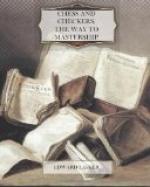White, in “castling King’s side” would place his King on g1 and the King’s Rook on f1; in “castling Queen’s side” the King would leap to c1 while the Queen’s Rook would take his stand on d1. Likewise Black would castle by either playing the King to g8 and the Rook from h8 to f8, or the King to c8 and the Rook to a8 to d8.
+---------------------------------------+ 8 | #R | | | | #K | | | #R | |---------------------------------------| 7 | #P | #P | #P | | #Q | #P | #P | #P | |---------------------------------------| 6 | | | #Kt| #P | | #Kt| | | |---------------------------------------| 5 | | | #B | | #P | | ^B | | |---------------------------------------| 4 | | | ^B | | ^P | | #B | | |---------------------------------------| 3 | | | ^Kt| ^P | | ^Kt| | | |---------------------------------------| 2 | ^P | ^P | ^P | ^Q | | ^P | ^P | ^P | |---------------------------------------| 1 | ^R | | | | ^K | | | ^R | +---------------------------------------+ a b c d e f g h
Diagram 3.
+---------------------------------------+ 8 | #R | #Kt| | | #K | | | #R | |---------------------------------------| 7 | #P | #P | | | | #P | #P | #P | |---------------------------------------| 6 | | | #P | | | | | | |---------------------------------------| 5 | | | | #P | ^P | | | | |---------------------------------------| 4 | | ^B | | | | ^P | | | |---------------------------------------| 3 | | | | | #Kt| ^Kt| | | |---------------------------------------| 2 | ^P | ^P | ^P | | | | ^P | ^P | |---------------------------------------| 1 | ^R | | | | ^K | | | ^R | +---------------------------------------+ a b c d e f g h
Diagram 4.
Castling is permitted only when neither King nor Rook concerned has previously moved, when none of the squares between the King and the Rook are obstructed and when none of the three squares involved in the King’s move are controlled by an adverse man. Thus if in check (see page 17) the player may not castle. In Diagram 4, neither White nor Black may castle.
SPECIAL TERMS
Attack and Defense
A man is said to attack another man if he moves so that on his next move he could capture the other man. Thus, in Diagram 5, White could attack Black’s Bishop by moving his Rook to d1 or to e6.
A man is said to defend or to protect another man if he moves so that in case the other man is captured by a hostile man he could recapture the latter. Thus, in Diagram 5, Black could defend his Bishop by moving his Knight to either e4 or e8 in case White attacks with the Rook from d1. Should White attack from e6, then Black would not defend the Bishop with the Knight, for on e4 as well as on e8 the Knight is unprotected and could be captured by the Rook without White losing anything in exchange. Black has a much more simple way to defend the attack of the Rook from e6, that is, by capturing the Rook with the Pawn f7. For this reason White would not have moved the Rook to e6.




